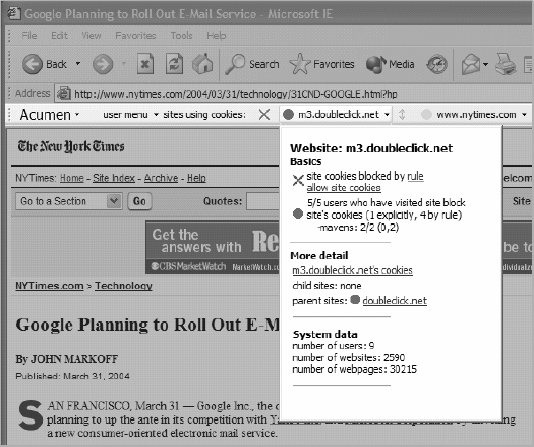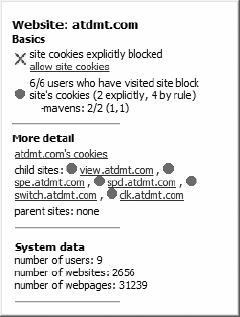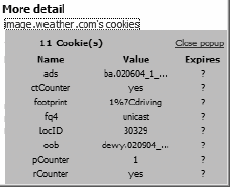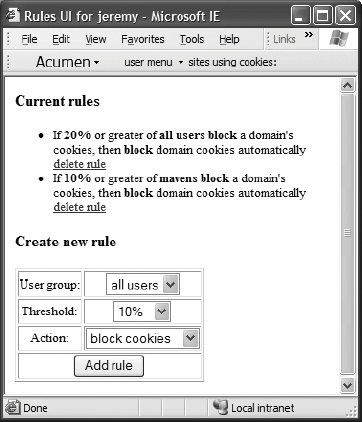Section 25.2. Acumen: A Solution Using Social Processes
25.2. Acumen: A Solution Using Social ProcessesThe Acumen system (see Figure 25-1) captures and makes visible people's cookie management actions. By making this information visible, Acumen enables users to employ social processes to maintain awareness of, learn about, and make decisions about their browser cookies. Acumen enables a group of users to manage their cookies via indirect collaboration through their actions; each individual user benefits by leveraging the group's collective knowledge and experiences. Acumen is a fully functional systemthe first system to make the actions of users within a community visible so that other members of that community can employ social processes when managing their privacy. Nevertheless, Acumen is a prototype, not a production system. Acumen is principally an exploratory systemboth in design and in implementationrather than a model of how to build a privacy management system that leverages social processes. We encourage other designers to draw from Acumen's features according to their users' privacy management needs. 25.2.1. Acumen OverviewAcumen enables users to manage cookies at the web site level, allowing or blocking each web site's cookies. Acumen allows all cookies by default; this default reflects the fact that most Internet users do not actively manage their cookies and thus do not block cookies. Acumen is an independent cookie management system and, as a consequence of architectural constraints, cannot interact with web browsers' cookie management tools. Thus, Acumen does not know which cookies are blocked by a web browser, and, conversely, cookies blocked by Acumen are never seen by the browser. Acumen captures and makes the following data visible in aggregate:
The "community" here is, of course, the community of Acumen users itself. This data is easy to collect because the collection imposes no additional burdens: users simply manage their cookies through the Acumen interface; Acumen records their actions and the resulting data, and aggregates the data for the benefit of the entire community, allowing users to see how others are managing their cookies. Figure 25-1. The Acumen system The data that Acumen provides can be utilized for many purposes: maintaining awareness of cookies, learning about cookies, and offering advice when deciding whether to allow or block a web site's cookies. Manually managing all cookies is tedious for users, and hence Acumen enables users to automatically manage cookies by employing simple rules that leverage Acumen's community-generated data. Users can create rules of the form: Users choose a rule's threshold percentage when they create the rule. The percentage of users that block (or allow) a site's cookies includes both users that block cookies explicitly and those that block cookies by rule. Thus, when one user's rule blocks a site's cookies, it can cause another user's rule with a higher threshold to block the site's cookies as well, and so on. This chain of rule applications acts like a social epidemic,[8] and it can propagate the blocking of a site's cookies quite quickly among users. We discuss the benefits and drawbacks of supporting such social epidemics later in this chapter.
Acumen makes data visible from all users and also from a select subset of users called mavens.[9] Mavens are, roughly, the users who are most active in explicitly blocking and allowing cookies. Users can specifically leverage mavens' data in Acumen's automation rules. We discuss mavens in more detail later as well.
25.2.2. The Acumen User InterfaceAcumen's user interface is integrated into web browsers so that it can provide ongoing, just-in-time support for cookie management. Acumen provides Internet Explorer users with a toolbar interface and Netscape/Mozilla/Firefox users with a Sidebar Tab interface; a Sidebar Tab[10] is a small (typically about 150-200 pixels wide), full-length, vertical window to the left of the main browsing window. Both interfaces present the same data, and we use the toolbar (shown in Figure 25-2) as the exemplar for this discussion.
Acumen's toolbar uses a just-in-time approach to provide cookie information. The toolbar lists the web sites that are using cookies on the page that the user is currently visiting. Next to each web site using cookies are two icons. The icon to the far left of the site name denotes whether the user allows or blocks the site's cookies; a green double arrow indicates that they are allowed, and a red X indicates that they are blocked. The circle icon to the immediate left of the web site's name denotes Acumen's community data for the site. Recall that this data is the number of Acumen users who have blocked/allowed a web site's cookies. The icon itself has two regions: an inner region and an outer region. The inner region's color denotes cookie management data for mavens; the outer region denotes data for all users (see Figure 25-2). Regions are colored using a stoplight motif. (The Privacy Bird uses a similar motif; see Chapter 22.) Green indicates that a great majority of users (90% or more) allow the site's cookies; yellow indicates that most users (75% to 90%) allow the site's cookies; and red indicates that only some users (less than 75%) allow the site's cookies. These thresholds are biased so that Acumen's user data icon will change color even if only a small number of users or mavens have blocked a site's cookies; we discuss these thresholds in more detail shortly. Clicking on a web site's name in the toolbar opens the site's menu (Figure 25-3). The menu's top section elaborates on the icons next to the site in the toolbar. If cookies are blocked, the menu indicates why; a link is provided to block/allow the site's cookies. User data is presented numerically, and the number of users who block the site's cookies explicitly and by rule are indicated. Figure 25-2. The outer circle is green, indicating that the majority of users accept cookies from this site; the inner circle is red, indicating that mavens do not allow cookies Figure 25-3. The web site menu offers detailed information about a web site The menu's middle section provides a link to view the cookies that a site uses (Figure 25-4) and provides links to menus for child and parent sites. An icon next to each child and parent site denotes the site's user data. These links enable users to explore Acumen's data via relationships between parent and child sites. For example, the menu for the site view.atdmt.com enables a user to easily navigate to the menu for its parent, atdmt.com, and block all cookies from this site. Blocking cookies from a parent site blocks cookies from all its child sites as well. The menu's lower section provides system information; the number of users, number of web sites, and number of documents in Acumen's database are displayed. This information is intended to serve as an incentive for users to utilize Acumen; users are more likely to use Acumen if they know that others are using the system and that there is data in the system. The toolbar also provides a user menu. The menu links to Acumen's rule interface (Figure 25-5) and indicates whether the user is currently a maven. Figure 25-4. Details about the cookies that a web site is using; each cookie's name, value, and expiration date are shown; because of architectural constraints, Acumen cannot always identify the expiration date for a cookie Figure 25-5. User interface for cookie management rules |
EAN: 2147483647
Pages: 295